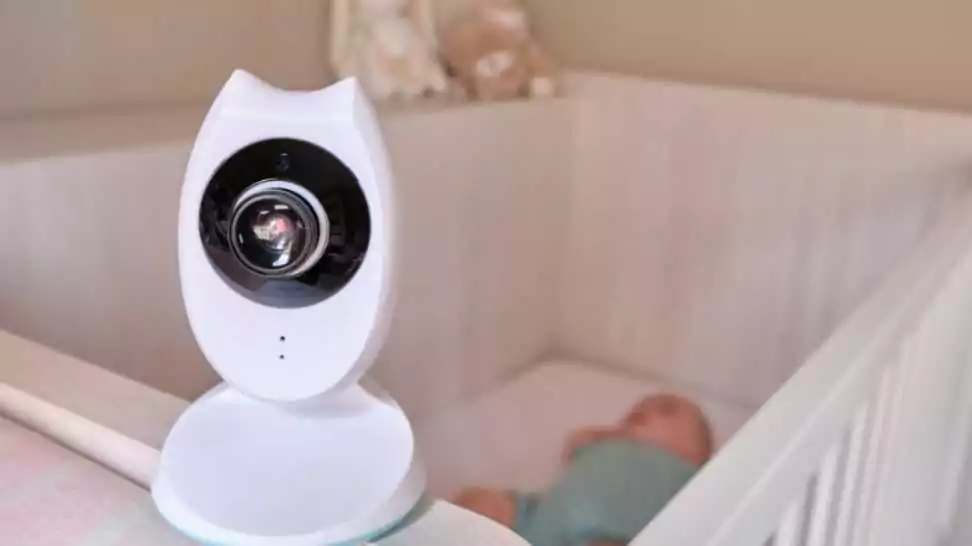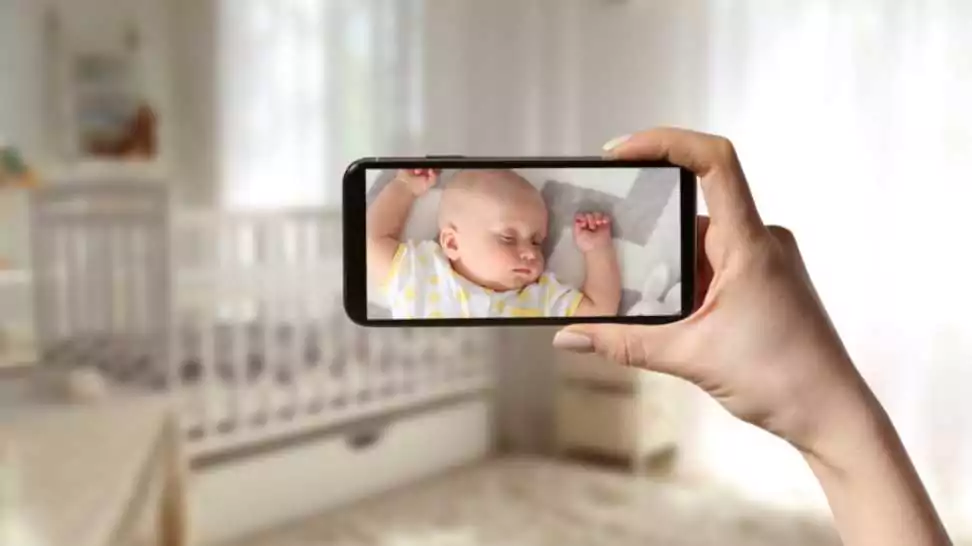A Closer Look At How Do Baby Monitors Work?

In today’s tech-savvy parenting world, baby monitors stand out as crucial tools for ensuring the safety and security of our children. Once basic audio devices that connected parents to their sleeping infants, these monitors have evolved significantly. Now, they range from straightforward audio-only models to advanced systems with video surveillance, movement sensors, and smartphone integration.
This guide delves into how do baby monitors work, exploring the various types, the technology behind them, and their benefits for parents. We aim to provide a comprehensive understanding of both basic and advanced features, helping both first-time and experienced parents make informed decisions about their family’s needs.
Join us in exploring the world of baby monitors, a journey aimed at equipping you with the knowledge to select the ideal option for your peace of mind and your baby’s safety.
1 The Basics of Baby Monitors
A baby monitor is a system used to remotely listen to, and in some cases, visually monitor the sounds and movements of an infant. This device acts as a bridge between the child and the caregiver, providing a way to keep a watchful eye and ear on the baby from a distance. It’s designed to alert parents or guardians of any noise, disturbance, or silence from the baby’s room, offering reassurance that the baby is safe and sound.
The concept of baby monitors dates back to the early 20th century, but it was in the 1930s that the first rudimentary models came into existence. Initially, these were simple audio devices, primarily used as a one-way communication tool to hear the baby from another room. Over the decades, technology evolved, and so did the features and capabilities of baby monitors, leading to the sophisticated devices we see today.
Types of Baby Monitors

- Audio-only Monitors: These are the most basic form of baby monitors. They transmit sound from the baby’s room to the parent unit, allowing caregivers to hear if the baby is crying or making other sounds. Despite their simplicity, audio monitors are highly effective and continue to be popular due to their affordability and ease of use.
- Video Monitors: A step up from audio-only, video monitors incorporate cameras to provide a visual element. Parents can not only hear but also see their baby, often in real-time. These monitors may include features like night vision, zoom, and pan/tilt capabilities to get a better view of the baby.
- Movement Sensor Monitors: Designed to alert parents if there is a lack of movement in the baby’s crib, these monitors are equipped with sensitive motion detectors. They are often used as a precautionary measure for infants at risk of health issues. Movement sensor monitors can come as standalone pads or be integrated into other types of monitors.
- Smart Monitors: The latest addition to the baby monitor family, smart monitors, connect to the internet and can be controlled through a smartphone app. They offer a range of features, including data analysis of the baby’s sleeping patterns, temperature monitoring, and the ability to control the monitor remotely.
How Each Type of Monitor Works

- Audio-only Monitors: They work on a simple transmitter and receiver model. The transmitter is placed in the baby’s room, capturing sounds and relaying them to the receiver unit held by the parent.
- Video Monitors: These combine the functionality of an audio monitor with a camera. The camera captures live footage of the baby, which is transmitted to a parent’s unit or a smartphone app. Many video monitors use a secure, encrypted signal to ensure privacy.
- Movement Sensor Monitors: These devices use sensor pads placed under the baby’s mattress to detect movement. If no movement is detected for a pre-set period, an alarm alerts the parents.
- Smart Monitors: Utilizing Wi-Fi or Bluetooth, smart monitors connect to a home network, allowing for remote access via a smartphone app. They can stream audio and video, and some models offer additional features like two-way communication, sensors for room temperature, and sleep-tracking analytics.
2 Technology Behind Baby Monitors
Audio Monitors
- Basic Functionality: Audio baby monitors function through a simple yet effective process. They consist of two main parts: a transmitter and a receiver. The transmitter, placed in the baby’s room, picks up sounds using a microphone and sends these audio signals to the receiver, which the parents keep nearby. This allows them to hear their baby from a different room.
- Analog vs Digital: The main difference lies in the transmission of sound. Analog monitors transmit continuous sound waves, while digital monitors convert sounds into digital signals before transmitting them. Digital monitors generally provide clearer sound quality and enhanced security, as they are less susceptible to interference and eavesdropping compared to analogue models.
Video Monitors
- Camera and Monitor Technology: Video baby monitors incorporate a camera unit in the baby’s room and a monitor unit for the parent. These cameras often include features like zoom, tilt, and pan, enabling parents to get a clear view of their baby. The monitors display real-time video feeds, and some models allow recording and snapshot capabilities.
- Infrared Night Vision: To ensure visibility in a dark room, many video monitors come with infrared night vision. This technology uses infrared LEDs to illuminate the room in a wavelength invisible to the human eye but detectable by the camera. This feature allows parents to see their baby in a completely dark room without any visible light to disturb the child’s sleep.
Movement Monitors
- Sensor Pad Functionality: Movement monitors typically use sensor pads placed under the baby’s mattress. These pads are sensitive to even the slightest movements, such as the baby’s breathing. If no movement is detected for a pre-set period, usually around 20 seconds, the monitor alerts the parents.
- False Alarms and Sensitivity: One challenge with movement monitors is the potential for false alarms, which can occur if the baby moves off the sensor pad or if the sensitivity settings are not correctly adjusted. Modern models have improved technology to minimize false alarms, and some allow parents to adjust sensitivity levels.
Smart Monitors
- Internet Connectivity and App Integration: Smart monitors are distinguished by their ability to connect to Wi-Fi or Bluetooth, enabling remote access through a smartphone app. This feature allows parents to monitor their baby from anywhere with an internet connection. Many of these apps also offer additional functionalities like sleep tracking, temperature monitoring, and customizable alerts.
- Data Encryption for Security: Given their connectivity, smart monitors prioritize security. Most employ data encryption and secure login processes to protect the privacy and security of the family. Encryption ensures that the audio and video data transmitted are only accessible to authorized users, safeguarding against hacking and unauthorized access.
3 Choosing the Right Baby Monitor

When it comes to selecting the perfect baby monitor for your family, several factors come into play. Understanding these key elements will help you make an informed decision, balancing functionality with your specific needs.
Factors to Consider
- Range: The range of a baby monitor is a critical factor, especially in larger homes or where there are multiple floors. A longer range ensures that the signal remains strong and uninterrupted, regardless of where you are in the house. Digital monitors generally offer a wider range compared to analogue ones.
- Battery Life: The longevity of the battery is another essential consideration. Monitors with longer battery life provide more flexibility and less frequent charging. Some models offer a power-saving mode or a feature that alerts you when the battery is low.
- Frequency: The frequency at which a monitor operates can affect its performance. Monitors that operate at a frequency of 2.4 GHz are common, but they might experience interference from other wireless devices like Wi-Fi routers. Choosing a monitor with a unique frequency can reduce interference and improve sound and video quality.
- Portability: If you move around the house frequently, consider a monitor that is portable and easy to carry. Some audio monitors come with belt clips for convenience, while others are compact enough to be easily moved from one place to another.
Comparing Features of Different Types of Monitors
Each type of monitor comes with its unique set of features:
- Audio Monitors are straightforward, focusing solely on sound transmission. They are ideal for those who prefer simplicity and are generally more affordable.
- Video Monitors offer the added benefit of visual monitoring. They are ideal for parents who want to see their baby’s movements and environment. Features like pan and tilt, zoom, and night vision enhance their functionality.
- Movement Monitors are specialized for detecting the slightest movements, making them suitable for parents who are concerned about sleep safety. However, they may be more expensive and can cause anxiety due to false alarms.
- Smart Monitors provide advanced features like app integration, data analysis, and remote access. They are perfect for tech-savvy parents but tend to be the most expensive.
Price Vs Performance
The cost of baby monitors varies widely. While it’s tempting to go for a high-end model with all the latest features, it’s important to assess whether those features align with your actual needs. Sometimes, a basic model may suffice, especially if your primary concern is simply to hear or see your baby when you’re not in the same room. Conversely, if you’re looking for more advanced features like movement detection or internet connectivity, investing in a more expensive model may be worthwhile.
4 Safety and Security Concerns
While baby monitors offer numerous benefits, it’s essential to be aware of potential safety and security concerns associated with their use. Understanding these risks can help you make informed choices and use these devices safely.
Potential Health Concerns
Radiation: One of the primary health concerns regarding baby monitors, especially wireless models, is the emission of electromagnetic radiation. While the level of radiation from these devices is generally low, some parents worry about the potential long-term effects of continuous exposure. To minimize risk, it’s advisable to place monitors at least a few feet away from the baby’s crib and to use them only when necessary.
Security Issues
Hacking of Digital Monitors: With the advent of smart monitors that connect to Wi-Fi or Bluetooth, the risk of hacking becomes a concern. Hackers could potentially gain access to the video and audio feed, breaching the family’s privacy. This issue is particularly pertinent for monitors that use unsecured internet connections.
Tips for Safe Usage

To address these concerns and ensure the safe usage of baby monitors, consider the following tips:
- Minimize Radiation Exposure: Choose a monitor with low emissions and place it at a safe distance from your baby’s sleep area. Avoid keeping the monitor on continuously, especially when the baby is awake or you’re in the same room.
- Secure Internet Connection: For smart monitors, ensure your home Wi-Fi network is secure. Use strong, unique passwords, and consider changing them regularly. Also, keep the monitor’s firmware updated to protect against security vulnerabilities.
- Choose a Trustworthy Brand: Opt for a well-known and reputable brand. Established brands are more likely to adhere to safety standards and offer secure, high-quality products.
- Be Cautious with Placement: Position the monitor and cords out of reach of the baby to prevent any strangulation hazards. Ensure that the camera, if used, is securely mounted and can’t fall into the crib.
- Regularly Check the Equipment: Periodically inspect the monitor for any damage, such as frayed wires or broken parts, and replace it if necessary.
5 Wrapping Up
Parenting, with its joys and challenges, calls for tools that offer peace of mind, such as baby monitors. This guide has highlighted their evolution from basic audio devices to multifunctional systems with video and smart technology, enhancing safety and security in child monitoring.
We’ve explored various types of baby monitors, each catering to different needs. Choosing the right one involves balancing technology, personal requirements, and safety. A suitable baby monitor not only fits your lifestyle but also ensures your child’s safety, becoming a crucial part of your parenting toolkit. As this field continues to evolve, staying informed helps you make decisions that transform a baby monitor from a mere gadget into a vital component of your parenting journey.
Community Q&A
About This Article
This article has been viewed 95 times.



